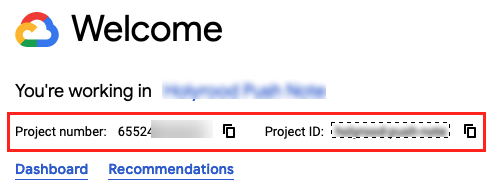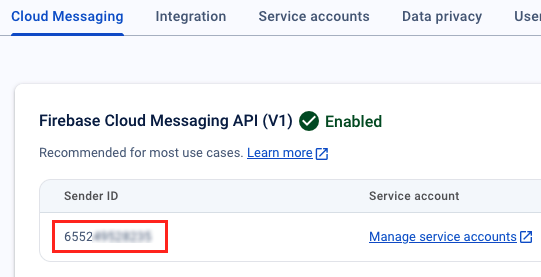Push Notifications-Troubleshooting | Native Apps
If you notice that a push was not sent out, start by checking the push history list.
You can find it under the menu Notification > Push > History .
If the status is green, this means that the push was sent to your users properly.
If you have an error:
1. Check all the followings points in this online help, for the platform impacted.
2. Contact the support team, specifying in detail if some of your settings need to be updated in your backend.
You can find it under the menu Notification > Push > History .
If the status is green, this means that the push was sent to your users properly.
If you have an error:
1. Check all the followings points in this online help, for the platform impacted.
2. Contact the support team, specifying in detail if some of your settings need to be updated in your backend.
1. Status Shows a Green Badge but the Push wasn't Received
Remember to check that notifications are authorized on your device :
- On iOS, in your phone settings
- On Android, in the settings page of the application (if you have included this page in your application)
Even if there is no Error notice it is possible that a push showing a green badge was not sent out to recipients.
We must remind you that Muse mBaaS doesn't handle the distribution of push notifications to recipients, but only sends on the dispatch request to Apple and Google servers. The request is then put on hold on their servers while waiting for dispatch to the recipients.
- On iOS, in your phone settings
- On Android, in the settings page of the application (if you have included this page in your application)
Even if there is no Error notice it is possible that a push showing a green badge was not sent out to recipients.
We must remind you that Muse mBaaS doesn't handle the distribution of push notifications to recipients, but only sends on the dispatch request to Apple and Google servers. The request is then put on hold on their servers while waiting for dispatch to the recipients.
2. Android - Google Cloud Console Settings
In the history, your push shows an orange badge and the mention "Push sent out on iOS and with error for Android".
This means, either that there is an error with your project number or your Firebase project's settings.
1. Log in to your Google console
2. Select your project
3. Check on your dashboard Google if your project ID matches the Google Console project ID in your back office (Publish > Android > Certificates ).

(There can be an API display error on browsers other than Chrome, we therefore recommend that you use this browser for this check up).

3. Android - Firebase Sender ID
1. Login to Firebase console
2. Check that your project Firebase is linked to your Google Console Project:
- Select your firebase project (created when building your Android app for the first time at step 7 of this online help)
- Click on the icon to the right of "Project Overview"
- Choose "Project Settings"
- Click the tab "Cloud Messaging"
- Check if the Sender ID on firebase matches the Google Console project number in your back office (Publish > Android > Certificates ).

4. Android - Firebase Server Key Token
1. Login to Firebase console
2. Select your Firebase project (created when building your Android app for the first time at step 7 of this online help)
3. Click on the icon to the right of "Project Overview"
4. Choose "Project Settings"
5. Click the tab "Cloud Messaging"
6. Check if the Server key token on Firebase matches the Firebase token for Cloud Messaging in your back office (Publish > Android > Certificates ).

5. Android - Firebase Android App
1. Login to Firebase console
2. Select your Firebase project (created when building your Android app for the first time at step 7 of this online help)
3. Click on the icon to the right of "Project Overview"
4. Choose "Project Settings"
5. Click the tab "General"
6. Check if the Package name set on Firebase matches the Package name in your back office (Publish > Android > Certificates ).
Once you have checked the points 2 through 5 above, contact the support team specifying in detail the following elements:
1. Which one of your settings need to be updated in your back office:
- Google console project ID
and/or
- Firebase Sender ID
and/or
- Server key
2. If the package name is properly set on your Firebase console.
Depending on your configuration, the support team will give you instructions on how to fix it.

Note: Once the issue is resolved, you will have to regenerate the Android application and send an update to the store, if it was already published
6. Dispatch Error on iOS
In the case of an error with the iOS push, always check the validity of your certificates in the menu Publish > iOS > Certificates in your backend.
- If the certificate is expired, read the online help regarding the update of your iOS certificates and carry on with the process as described.
- If the dispatch error on iOS remains with the updated certificates, please read on.
- If the certificate is expired, read the online help regarding the update of your iOS certificates and carry on with the process as described.
- If the dispatch error on iOS remains with the updated certificates, please read on.
7. iOS - Verify the Push Notification SSL Service (Production)
1. Log in your Apple developer account >Certificates, Identifiers & profiles https://developer.apple.com/account/resources/certificates/list
2. In the Identifier menu, select the App ID registered in your backend in Publish > Certificates > iOS
3. Click on the App ID to display the capabilities.
4. Scroll down until you find the line "Push Notifications".
4. Click on Configure or Edit


The Push Certificate must be a Production SSL Certificate.
If you created a Development SSL Certificate instead, the push won't work.
To fix this:
Click on the Revoke button to delete the existing certificates
Click on done at the bottom of page.
Follow the online help regarding the update of iOS certificates, starting at step 4.
You don't have to regenerate your iOS application or submit an update of your application to the App Store after your certificates are updated.
Related Articles
Scheduled Push Notification | Native Apps
This feature allows you to schedule push notifications to be sent automatically when new content is published in a specific section of your app. This is a different feature than the regular push, which allows you to send pushes manually one at the ...How to use Push Notifications | Native Apps
Push notifications allow an app to notify users of new messages or events without the need to actually open the application, the same way a text message will sound and appear on the user's screen. This is a great way to interact with your users. With ...How to use Push Notifications | PWA
Standard plan (PWA only): 500,000 push notifications per month ( = 1 notification per month if you have 500,000 users, 10 notifications per month if you have 50,000 users, 100 notifications per month if you have 5,000 users, etc.) Full plan (PWA, ...Push Settings on Users Side | Native Apps
1. Install the Authentication Extension 1. Go to the menu Extensions Store > All extensions 2. Click "Authentication" extension. 3. Click "Install" 2. Push Notifications History Users are able to see push notifications history in their profile page. ...Scheduled Push Notifications | PWA
This feature allows you to schedule push notifications to be sent automatically when new content is published in a specific section of your app. This is a different feature than the regular push, which allows you to send pushes manually one at the ...